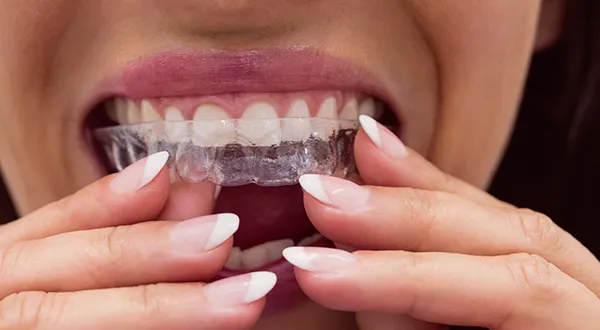

The Science Behind Invisalign's Invisible Magic
Have you ever wondered how Invisalign's clear aligners work to straighten teeth? Invisalign has been one of the most popular invisible orthodontic treatments for the past few years and has revolutionized how we approach teeth straightening. Invisalign's technology and powerful tagline, "Transforming smiles, changing lives," make it the clear choice in orthodontics. But how does it work? This blog post will explore the science behind Invisalign's technology and its unique advantages over traditional braces. So, let's dive in!
Material Composition of Invisalign
The material composition of Invisalign aligners is a crucial aspect that contributes to their effectiveness, comfort, and discreet nature. Invisalign aligners are crafted from a specialized thermoplastic material known as SmartTrack. Here's a closer look at the Invisalign material composition:
SmartTrack Material:
- Polyurethane-Based: Invisalign aligners are primarily made from a polyurethane-based resin. Polyurethane is a polymer known for its flexibility, durability, and biocompatibility, making it suitable for medical and dental applications.
- Biocompatibility: SmartTrack material is carefully chosen for its biocompatibility, ensuring that it is safe for intraoral use without causing adverse reactions or irritation to the mouth's soft tissues.
Transparent and Clear:
- Polycrystalline Structure: The SmartTrack material has a polycrystalline structure, contributing to its transparency. This transparency is crucial in making Invisalign aligners virtually invisible when worn, addressing aesthetic concerns associated with traditional braces.
Flexibility and Elasticity:
- Thermoplastic Nature: SmartTrack is a material that becomes pliable when heated and retains shape when cooled. This property allows the aligners to be easily placed over the teeth and ensures a snug fit.
- Optimal Elasticity: The material's elasticity is carefully engineered to provide the proper force for controlled tooth movement. This controlled force is essential for effective invisible orthodontic treatment while maintaining patient comfort.
Durability:
- Wear-Resistant: SmartTrack is designed to be wear-resistant, ensuring the aligners maintain structural integrity throughout treatment. This durability is essential for withstanding the daily wear and tear of chewing and speaking.
Stain Resistance:
- Non-Porous Surface: The SmartTrack material has a non-porous surface that resists staining. This feature helps the aligners remain clear and transparent, preserving their aesthetic appeal throughout the treatment.
Customization for Individual Cases:
- CAD/CAM Technology: The material is used with advanced Computer-Aided Design/Computer-Aided Manufacturing (CAD/CAM) technology. This ensures precise customization of each aligner according to the individual's treatment plan, optimizing the alignment process.

Biomechanics of Tooth Movement
The biomechanics of tooth movement is a fascinating aspect of invisible orthodontics, and understanding how Invisalign leverages these principles sheds light on the science behind its effective teeth-straightening technology.
Physiological Response to Force:
- Remodeling Bone: Tooth movement is primarily achieved through the controlled application of force. In response to this force, bone tissue in the jaw undergoes remodeling. Cells called osteoblasts and osteoclasts play a crucial role in reshaping the bone to accommodate the shifting teeth.
Gradual and Controlled Movement:
- Invisalign Aligners' Role: Invisalign aligners utilize the principles of biomechanics to induce gradual and controlled tooth movement. Each set of aligners is specifically designed to exert precise forces on targeted teeth at different stages of the treatment plan.
- Sequential Aligner Series: The treatment plan involves a series of sequential aligners, each slightly different from the previous one. This incremental adjustment ensures a systematic and gentle progression of tooth movement over time.
SmartForce Features:
- Attachments and Buttons: In some instances, Invisalign treatment may incorporate SmartForce features, such as attachments or buttons. These are small, tooth-colored shapes strategically placed on the teeth. They serve as additional points for the aligners to apply force, enhancing the precision of movement.
- Enhanced Control: SmartForce features allow for more complex tooth movements and improved control over the direction and intensity of the applied forces. This contributes to Invisalign's effectiveness in treating various orthodontic issues.
Optimal Force Application:
- 3D Treatment Planning: Invisalign's 3D treatment planning technology is pivotal in optimizing force application. The digital modeling of the patient's dentition allows for a comprehensive view of the tooth positions and enables the prediction of the optimal force required for each movement stage.
- Predictable Outcomes: By precisely calculating and applying forces, Invisalign aims to achieve predictable outcomes, ensuring that teeth move in the desired direction without causing unnecessary discomfort or compromising oral health.
Comfort and Adaptability:
- SmartTrack Material: The flexibility and elasticity of the SmartTrack material contribute to the overall comfort of Invisalign treatment. The aligners are designed to fit over the teeth, applying the necessary forces while minimizing discomfort for the wearer.
Monitoring and Adjustments:
- Regular Check-ups: Monitoring tooth movement progress is crucial to Invisalign treatment. Regular check-ups allow adjustments to the treatment plan, ensuring the aligners continue guiding the teeth toward the desired alignment.
In essence, the biomechanics of tooth movement in Invisalign treatment involve a carefully orchestrated interplay of material properties, digital technology, and strategic force application. This nuanced approach aims to achieve straighter teeth and a harmonious and stable bite, ultimately enhancing the patient's oral health and well-being.
Attachment Points
Attachment points, also known as buttons or attachments, play a crucial role in the effectiveness of Invisalign treatment. These small, tooth-colored features are strategically placed on specific teeth to enhance the precision and control of tooth movement throughout the orthodontic process. Understanding the significance of attachment points provides insight into how Invisalign technology achieves complex and targeted tooth adjustments.

Purpose of Attachment Points
- Facilitating Specific Movements: Attachment points enable specific tooth movements that may be challenging with aligners alone. They act as anchor points for the aligners, allowing them to exert controlled forces on the teeth in precise directions.
- Enhancing Predictability: By using attachment points, orthodontists can improve the predictability of tooth movement. This is particularly valuable for addressing complex cases like rotations, intrusions, or extrusions.
Types of Attachment Points:
Tooth-Colored Material: Attachment points are typically made from tooth-colored composite material, ensuring they blend seamlessly with the natural color of the teeth. This aesthetic consideration aligns with Invisalign's commitment to invisible orthodontic solutions.
Varied Shapes and Sizes: Attachments come in various shapes and sizes, each serving a specific purpose based on the required movement. Some attachments may be more noticeable, depending on their location and function.
- Placement Process:
- Customized Placement: The placement of attachment points is a highly customized aspect of Invisalign treatment. Orthodontists carefully plan and position each attachment based on the individual's treatment plan, considering the specific tooth movements required for optimal results.
- Computer-Aided Precision: Invisalign's computer-aided design (CAD) technology is crucial in determining the exact placement of attachment points. This precision ensures that the Invisalign aligners when worn over the attachments, apply the intended forces for targeted tooth adjustments.
- Role in Complex Cases:
- Addressing Difficult Movements: Attachment points are precious in addressing more complex movements, such as the rotation of teeth or the correction of specific bite issues. They provide additional leverage and control over the direction and magnitude of the forces applied.
- Versatility in Treatment: The use of attachment points expands the versatility of Invisalign, allowing it to treat a wide range of orthodontic issues beyond simple misalignments.
- Patient Experience:
- Comfort and Adaptability: While attachment points may seem like small protrusions on the teeth, patients often adapt quickly to their presence. The overall comfort of the Invisalign treatment, combined with the aesthetic appeal of tooth-colored attachments, contributes to a positive patient experience.
- Maintenance and Care:
- Easy Removal and Replacement: Attachment points are designed for easy removal and replacement during treatment. They are replaced as needed, ensuring that the orthodontic plan evolves with tooth movement progress.
In the ever-evolving landscape of dental technology, Invisalign aligners stand as a beacon of progress, reshaping not only smiles but also the expectations of what orthodontic treatment can achieve. With a blend of art and science, Invisalign technology has set a new standard for discreet, effective, and patient-friendly teeth straightening, leaving an indelible mark on the journey to a confident and radiant smile.
Contact your Lafayette dentist, Dr. Massood Darvishzadeh, DDS at Lafayette Dental Group, to learn more about the science behind Invisalign's invisible magic.
Resources:
Invisalign vs. Traditional Braces: Making the Right Choice
*This media/content or any other on this website does not prescribe, recommend, or prevent any treatment or procedure. Therefore, we highly recommend that you get the advice of a qualified dentist or other medical practitioners regarding your specific dental condition*
Services
Contact Us
3466 Mt Diablo Blvd., Suite C207
Lafayette, CA 94549
2026 © Lafayette Dental Group | All rights reserved | Powered by: Vigorant, Inc.
